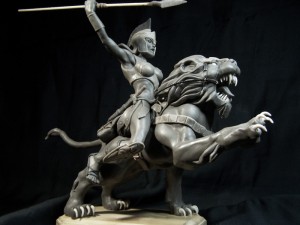Guy C. Rothery
Amazons
Amazons is the name used by classical writers(k) to identify two matriarchal nations living near the Black Sea and in ancient Libya, but at apparently  different periods. An extensive website on the subject associates the Amazons with three locations; Lake Tritonis(j) , the Greek island of Lemnos(i) and the River Thermodon, now known as Terme Çay, in northern Turkey(h).
different periods. An extensive website on the subject associates the Amazons with three locations; Lake Tritonis(j) , the Greek island of Lemnos(i) and the River Thermodon, now known as Terme Çay, in northern Turkey(h).
Accounts relating to these remote times are understandably vague but one tale describes the Libyan Amazons as waging war against the Atlanteans, a race who lived in a prosperous country with great cities.
Attention has been drawn to the fact that the Berbers, also known as Amazigh in North-West Africa have a matriarchal culture. The possibility of an etymological connection between Amazon and Amazigh was suggested by Guy C. Rothery (1863-1940) in his 1910 book, The Amazons[1393] , and recently endorsed by Emmet Sweeney in his Atlantis: The Evidence of Science[700]. In 1912, Florence Mary Bennett published Religious Cults Associated with the Amazons[1548], which has been republished in recent years.
Another matriarchal society in the same region has also been suggested for the Maltese Islands(h).
Sir John Chardin (1643-1713) a French-born traveller and merchant reported that a tribe of Amazons still existed in the Caucasus in the 17th century(d).
Although the idea may be seen as fanciful, recent archaeological discoveries have provided evidence of female warriors in ancient times in parts of the former Soviet Union. The archaeologist Jeannine Davis-Kimball has written of her investigations[045] into the subject. Peter James offers[046] a solution to the existence of two locations for the Amazons. He believes that the original Black Sea location is correct and that the transference of the story to North Africa was the result of the ‘libyanising’ intent of Dionysus of Miletus, who was later quoted by Diodorus Siculus in his account(f) of the Amazons.
. James offers this explanation as part of a larger relocation of mythologies to more westerly locations. Other interesting views of the Amazon mystery can be found on a number of websites(a)(b).
Lewis Spence advanced the imaginative view [259.49] that the Amazons were not women at all, but men whose appearance was considered effeminate by some commentators. A more rational explanation on offer is that the males of some peoples had little facial hair or shaved (such as the Hittites) and were possibly described by their more hirsute enemies as ‘women’.
The popular idea that the Amazons were single-breasted, man-hating warriors has recently been comprehensively debunked by Adrienne Mayor in her latest book, The Amazons[1043] .
>Even more eyebrow-raising is the suggestion that Amazon warriors existed in South America based on 16th century reports and modern research(c). Columbus, in a 1493 letter to Luis de Sant’angel, refers to an island named Matininó, which was inhabited only by women(m), armed with bows and arrows. Hernán Cortés also filed a similar report.<
The Smithsonian magazine published a useful overview(e) of the history of the Amazon story in the April 2004 edition and in September 2011 revealed the story of the little-known female warriors of Benin (formerly Dahomey), numbered in their thousands, who were active during the 17th, 18th and 19th centuries. The BBC published an article in August 2018 on their history and their modern day descendants(l) .
(a) https://www.maicar.com/GML/AMAZONS.html
(b) https://web.archive.org/web/20190509212918/https://www.amazonation.com/Archaeology.html
(c) https://brazilweirdnews.blogspot.ie/2011/05/amazons-phoenicians-and-atlantis.html
(d) https://www.abebooks.com/Travels-Sir-John-Chardin-Persia-East/5455430940/bd
(e) https://www.smithsonianmag.com/history/amazon-women-there-any-truth-behind-myth-180950188/?no-ist
(f) https://archive.org/details/lp0048_amazons_vs_at
(g) https://www.smithsonianmag.com/history/dahomeys-women-warriors-88286072/?no-ist
(h) https://www.myrine.at/Amazons/mobilIndex.html
(i) https://www.myrine.at/Lemnos/mobilLemnos.html
(j) https://www.myrine.at/Berber/mobilBerber.html
(k) https://www.myrine.at/Amazons/texts_e.html
(l) https://www.bbc.com/travel/story/20180826-the-legend-of-benins-fearless-female-warriors
>(m) https://tanlistwa.com/2018/02/22/martinica-women-island-iguanas-island-or-flowers-island/<
